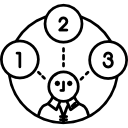GUI

Command line interface[1]
The graphical user interface (GUI) is a form of user interface that allows users to interact with electronic devices through graphical icons and visual indicators such as secondary notation, instead of text-based user interfaces, typed command labels or text navigation. GUIs were introduced in reaction to the perceived steep learning curve of command-line interfaces (CLI) which require commands to be typed on a computer keyboard.[2]
Parts of a GUI
Traditionally, GUI's have windows, icons, menu's and a pointer.
- A window runs a self-contained program, isolated from other programs that (if in a multi-program operating system) run at the same time in other windows.
- An icon acts as a shortcut to an action the computer performs (e.g., execute a program or task).
- A menu is a text or icon-based selection system that selects and executes programs or tasks.
- The pointer is an onscreen symbol that represents movement of a physical device that the user controls to select icons, data elements, etc.
This style of system improves human–computer interaction (HCI) by emulating real-world interactions and providing better ease of use for non-technical people. Users can carry skill at a standardized interface from one application to another[3]